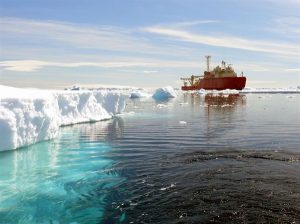Pacific Arctic Observations Addressing Causes and Consequences of Sea Ice Loss
 In 2015, NOAA’s Arctic Research Program competitively funded three new five-year projects involving $4.2 million in grants (and benefit from additional support by interagency and international partners). Through these three new projects, university partners will help to carry out multidisciplinary observations and research for five years (from 2015 to 2020), in support of analysis, and modeling in the Pacific Arctic, i.e., the Chukchi Beaufort Sea, the East Siberian Sea, and the Arctic Ocean north of these regions.
In 2015, NOAA’s Arctic Research Program competitively funded three new five-year projects involving $4.2 million in grants (and benefit from additional support by interagency and international partners). Through these three new projects, university partners will help to carry out multidisciplinary observations and research for five years (from 2015 to 2020), in support of analysis, and modeling in the Pacific Arctic, i.e., the Chukchi Beaufort Sea, the East Siberian Sea, and the Arctic Ocean north of these regions.
The Arctic Research Program supports several in situ observing networks critical to observing, understanding, and predicting the rapidly changing Arctic environment and characterizing the impacts of these changes to the Arctic environment and potential changes in mid-latitude weather: International Arctic Buoy Programme (IABP); Arctic Sea Ice Thickness Network; The Russian-American Long-term Census of the Arctic (RUSALCA) program; and International Arctic System for Observing the Atmosphere (IASOA).
In addition, the ARP supports the Distributed Biological Observatory (DBO) and is in the early stages of developing the Pacific Arctic Climate Ecosystem Observatory (CEO).
The Arctic Research Program specifically requested proposals to: Continue the long-term observations of the extended DBO (on both Russian and US sides of the Chukchi Sea) transect. During the next decade of RUSALCA the DBO will be extended westward further north where the Arctic has become even more ice-free. This is part of the Climate Observations Division priority to build a suite of repeat hydrography and ecosystem transects in the Arctic. These new observations will extend previous transects established in 2004 to 2012. Applicants were also encouraged to design new sets of sentinel stations and repeat transects that will be reoccupied during the award period and provide data harmonious with previously collected data. It is anticipated that this work will be carried out with coordination of vessels from Pacific Arctic Group partner countries and other nations, if possible.
Observations collected from these expeditions are expected to be assimilated to improve model-based capabilities that address impacts of Pacific Arctic sea ice loss on the Pacific Arctic Ocean and its ecosystems and improve models that link long-term sea ice reductions to impacts on the mid-latitudes.
The three new projects to be funded by the Arctic Research Program in 2015 are:
“Changes of heat and freshwater budgets in the East Siberian Sea and southern Makarov Basin contributing to multidisciplinary changes in the Pacific Arctic,” PI: Igor Polyakov, Co PI’s: Andrey Pnyushkov, Georgina Gibson, Robert Rember, Terry Whitledge, Dean Stockwell and Peter Winsor, all from the University of Alaska Fairbanks
“Changes of heat and freshwater budgets in the East Siberian Sea and southern Makarov Basin contributing to multidisciplinary changes in the Pacific Arctic,” PI: Matthew Alkire, University of Washington
“Coordination, Data Management and Enhancement of the International Arctic Buoy Programme,” PI: Ignatius Rigor, University of Washington
The Arctic Research Program is a program in the Climate Observation Division, Climate Program Office, within NOAA’s Office of Oceanic and Atmospheric Research that supports research to advance Arctic observations in the atmosphere, ice, ocean, and ecosystems. http://cpo.noaa.gov/ClimatePrograms and www.arctic.noaa.gov.
For a full list of CPO’s grants and awards for 2015, visit: http://cpo.noaa.gov/AboutCPO/AllNews/TabId/315/artmid/668/articleid/363879/CPO-Announces-FY15-Awards.aspx
NOAA’s Climate Program Office helps improve understanding of climate variability and change in order to enhance society’s ability to plan and respond. NOAA provides science, data, and information that Americans want and need to understand how climate conditions are changing. Without NOAA’s long-term climate observing, monitoring, research, and modeling capabilities we couldn’t quantify where and how climate conditions have changed, nor could we predict where and how they’re likely to change.